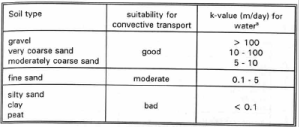

| Components |
||||
| UNDERSTANDING SOIL SYSTEMS | ||||
| Before deciding which methods
to use in the remediation of contaminated soils, it is imperative
to first analyze the current site soil conditions. Since in situ bioremediation
depends heavily on naturally occurring microbial activity in restoring
soil systems, it is important to understand the environmental parameters
that affect microbial activity. The following portions of this article
will therefore discuss these parameters and how they affect in situ
bioremediation applications. Environmental parameters affecting microbial activity: |
||||
|
||||
| Intrinsic permeability, soil structure, and soil stratification all are factors that affect the efficacy of in situ bioremediation. | ||||
| 2.1.1
Intrinsic Permeability The intrinsic permeability of soils is a measurement of their ability to transmit air. This is the single most important factor influencing the efficacy of in situ bioremediation. Certain types of soils with a particular structure and grain size distribution are more favorable for bioremediation than others. Below is a table that shows the different levels of permeability among soils and their suitability for convective transport (i.e. oxygen transport). |
||||
 |
||||
| Fig.2 | ||||
| 2.1.2
Soil Structure & Stratification Understanding soil structure and stratification is also important when applying bioventing and biosparging methods, as these also influence air flow movement throughout the soil matrix. Structural characteristics like microfracturing can improve permeability even in fine-grained soils (e.g. clays) where high permeability levels would otherwise be unlikely. Increased air flow would only occur, however, in fractured, rather than unfractured, media. Furthermore, soil structure affects the amount of pressure required in biosparging methods. For example, fine-grained soils require higher biosparging pressures due to restricted air flow through smaller pores. In addition, stratification of heterogeneous soil systems may alter air flow behavior. For example, layers containing coarse soils will exhibit dramatically higher levels of soil vapor lateral flow than fine-grained soils, where air movement is minimal. This altered flow behavior can result in the unanticipated migration of constituents. |
||||
| |
||||
2.2 Contaminant Distribution Contaminant distribution determines the feasibility of using bioremediation methods. Contaminants can reside in the unsaturated zone, also referred as the vadose zone, of soil systems in one or more of the following forms: |
||||
 |
1) As gas vapor within soil pores 2) As pure mobile or immobile non-aqueous phase liquids (NAPL) 3) Attached to soil particles 4) In an aqueous state, i.e. dissolved in soil moisture or ground water. |
|||
| Since bioremediation relies on degradative processes to metabolize contaminants, these contaminants must be (bio)available to the soil microorganisms. Generally, contaminants that have lower aqueous solubilities, enter soils as a pure product, and/or are likely to be absorbed to soil particles, are not bioavailable to soil microorganisms. In order for biodegradation to occur, contaminants must be available within the soil in aqueous or gaseous form. | ||||
|
2.3 Soil pH Microorganisms generally survive at pH levels ranging from 5 to 9. For bioremediation applications, the optimum pH is usually slightly above 7, where microorganisms perform degradative processes at a relatively fast and efficient rate. However, the optimum pH for microbial growth varies among species of microorganism. Acceptable pH levels for bioventing and biosparging range from 6 to 8. Soils chosen for remediation with pH levels outside this range may need to be modified before and during bioventing and/or biosparging. However, pH modification may also lead to later, sudden changes in pH that hinder bacterial activity. |
||||
|
2.4 Soil Temperature The temperature of soil systems also affects the performance of bioremediation. Occurring between 10oC and 45oC, microbial activity typically doubles for every 10oC increase in temperature. However, temperatures outside this range most often bring microbial activity to a standstill. |
||||
2.5 Soil Moisture Content Microorganisms, i.e. bacteria, require moist soil conditions for proper cell growth. Too much soil moisture, however, can hinder the distribution and availability of oxygen to bacteria. Ideal soil moisture conditions are therefore between 40-85 percent of the soil’s water-holding capability. |
||||
|
2.6 Nutrient Supply Bacteria also require inorganic nutrients to sustain cell growth and the biodegradation process. These nutrients generally include nitrogen, phosphorous, potassium, sulfur, magnesium, calcium, manganese, iron, zinc, copper, and trace elements. However, in situ bioremediation normally only requires the introduction of nitrogen and phosphorous, usually in the form of ammonium (nitrogen) and phosphate (phosphorous). |
||||
|
||||
|
||||
|
|
||||
| |
||||
|
||||
|
||||